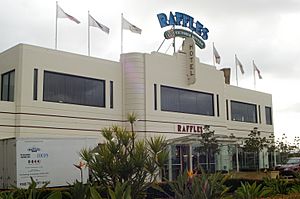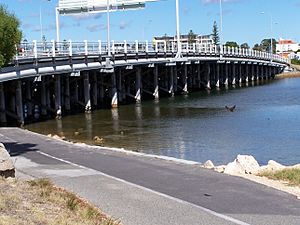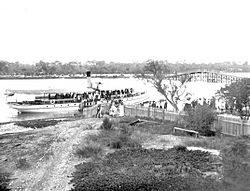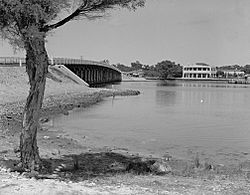Canning Bridge facts for kids
Quick facts for kids Designations |
|
|---|---|
| Designated | 2 March 2012 |
| Reference no. | 16178 |
The Canning Bridge is a very important traffic bridge in Perth, Western Australia. It is the last bridge you cross on the Canning River before it meets the Swan River. This bridge is part of Canning Highway. It connects the suburbs of Como and Applecross. The Canning River is about 100 metres (328 feet) wide here. This is the narrowest part of the river in its lower section. The bridge is also close to the Canning Bridge railway station.
Contents
History of Canning Bridge
Did you know that four different bridges have stood at this spot? Let's learn about each one!
First Bridge: 1849
The very first bridge was planned in 1846 by Henry Trigg. He was in charge of public works back then. The bridge was designed to be 520 feet (175 metres) long and 12 feet (4 metres) wide. It had a main section 24 feet (8 metres) long. The bridge deck was only 8 feet (2 metres) above the river water.
Building started in 1849 because earlier offers were too expensive. Solomon Cook built this first bridge for £425. It was a super important link. It connected Fremantle, Perth, and Guildford.
Second Bridge: 1867
Big floods hit the Swan and Canning Rivers in 1862. These floods damaged the Canning and Helena Bridges. They also damaged The Causeway. Because of this, a new Canning Bridge was built in 1867. Convicts helped build this second bridge.
This new bridge was 12 feet (4 metres) above the river water. In 1892, the bridge deck was raised even higher. It then sat 18 feet (6 metres) above the water.
Third Bridge: 1908
The second bridge slowly got old and worn out. This was due to not enough repairs. A fire also damaged part of the bridge. Since the road was so important for traffic, money was given for a new bridge in 1907 and 1908.
The third bridge was built in 1908. It cost £2,023. This bridge was much stronger than the last one. It was built a little to the south-east of where the current bridge is now.
Current Bridge: 1939
Work on the bridge we see today started in 1938. This new bridge cost £24,830. It opened in December 1939. It was built using strong timbers like Jarrah, Karri, and wandoo. The bridge has three sections for boats to pass under. Two sections are 24 metres (79 feet) long. One section is 18 metres (59 feet) long. The whole bridge is 175 metres (574 feet) long.
When World War II started, the old third bridge was not taken down right away. People wanted to keep it just in case the new bridge was damaged. The third bridge stayed until the late 1940s.
The 1939 bridge is still standing today! However, it has been changed a lot over the years. Now, it only carries traffic going east on Canning Highway. In 1958, another timber bridge was built next to the 1939 bridge. This new bridge was on the upstream (southern) side. It helped to double the amount of traffic the bridge could handle. This newer bridge even had a fishing platform underneath it.
In 1958, the 1939 bridge was made shorter on its eastern end. This was to make space for a ramp to the new Kwinana Freeway. Then, between 1965 and 1966, both the 1939 and 1958 bridges were made wider. This added more support to each bridge. The fishing platform under the 1958 bridge was also made bigger.
In 1976, a strong concrete layer was added to the top of the 1939 bridge. The same was done to the 1958 bridge in 1984. In 1994-1995, some of the original timber parts of the 1939 bridge were replaced with steel. This was because of damage. Other repairs were also done to the bridge's structure.
In 1997, the concrete layers on both bridges were replaced. This was expected to make the bridges last another 40 years! More concrete was used in 1998-1999 to protect the bridge even more.
Raffles Hotel

The Canning Bridge area was a good spot for places to stay and eat. This is because it was on the road from Fremantle to Perth and Guildford. So, in 1896, the Canning Bridge Hotel was built near the bridge. It was on the western (Applecross) side.
This building was greatly improved in 1939. It got a special Art Deco look designed by architect William G. Bennett. This happened at the same time the current bridge was being built. The building was renamed the Raffles Hotel. It was named after the famous hotel in Singapore.
The Raffles Hotel was a very popular place in Perth in the 1940s and 1950s. It was known for its bright neon signs advertising beer. In the 1970s and 1980s, the Raffles was famous for its live music. Many popular local and interstate bands played there.
In 2002, the land was sold to a company called Multiplex. They built a 17-storey apartment tower there. As part of the plan, the old 1939 Art Deco building was kept and fixed up.
Heritage Status
In March 2012, the Canning Bridge was added to the Western Australian State Heritage list. This means it is an important historical place that needs to be protected.





